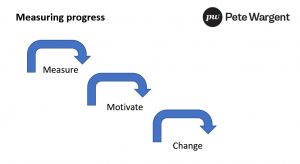Work in progress
About a decade ago I began an annual exercise of setting goals in various areas of my life, & these days I review my progress in detail once a year at a dedicated week’s retreat on the Gold Coast, before once again setting targets for the year ahead.
Perhaps because I’m an accountant, I’ve found that quantitative measures of progress are more practical than qualitative measures.
For example, if you’re dieting you can record your weight in pounds or take a percentage reading of body fat, while if you’re saving for a home deposit then your bank balance denotes your progress numerically, though sometimes a simple rating system out of 10 can work too.
Smart goals should be easily quantifiable so you know when you’re closer to achieving them, bringing a sense of accomplishment.
A goal worth setting is worth measuring
Loosely following the model laid out by Anthony Robbins in his classic book Awaken the Giant Within, I like to set myself annual targets in 4 main areas:
- Business & investment goals
- Personal development & health goals
- Material & adventure goals
- Contribution goals
Once your objectives are set, you can break these goals down to create an action plan to hit them, & then keep a record of your progress.
It’s ideal to measure results, partly because ‘what gets measured gets done’, while you can then use the results as powerful motivation to implement further positive changes.

4 ways to measure progress
There are multiple methods for measuring progress, & here are 4 of the ways you might choose to approach it:
(i) Process targets – if, for example, you want to make more sales, the critical processes you might choose to record could include pitches or proposals, client meetings, or telephone calls to prospects.
It’s important that you measure the appropriate processes – be they based on time, quality, cost, or output – being those that will deliver genuine results;
(ii) How far you’ve travelled – it can be supremely motivating to look back at where you started & acknowledge how far you’ve progressed to date, especially as your results begin to flourish;
(iii) Distance remaining to smash your goals – an alternative way to view your progress is to assess how far you have left to travel to hit your targets. It’s likely to be helpful not to do this when the goals are too distant, as this might prove to be demoralising!; and
(iv) Regular re-measurement – taking regular measurements of progress can be an effective means of holding yourself accountable, while ensuring transparency as you advance towards your goals.
Setting goals & measuring progress is a great was to keep your journey on track, and in my experience it’s much harder to improve what you can’t or don’t measure.
Look for patterns of what’s working & what isn’t, and be persistent, for the incremental gains over time will compound into vast improvements.






